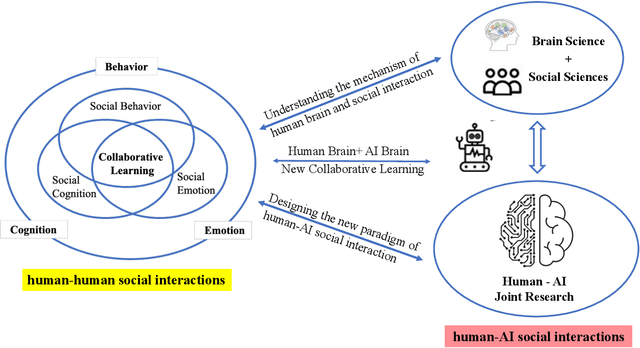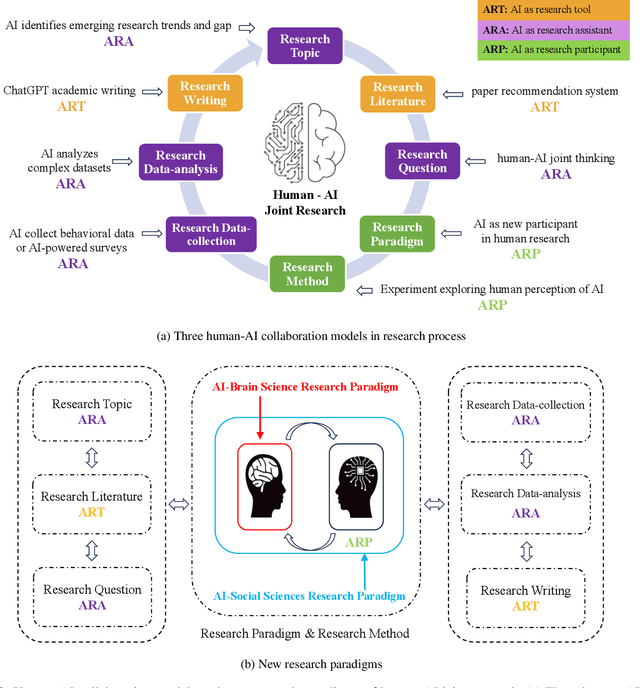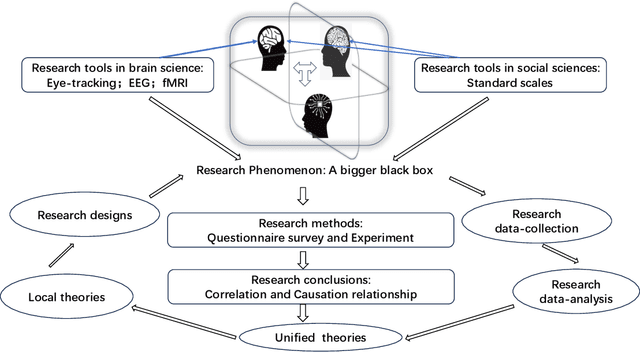Feng Xiong
JanusVLN: Decoupling Semantics and Spatiality with Dual Implicit Memory for Vision-Language Navigation
Sep 26, 2025Abstract:Vision-and-Language Navigation requires an embodied agent to navigate through unseen environments, guided by natural language instructions and a continuous video stream. Recent advances in VLN have been driven by the powerful semantic understanding of Multimodal Large Language Models. However, these methods typically rely on explicit semantic memory, such as building textual cognitive maps or storing historical visual frames. This type of method suffers from spatial information loss, computational redundancy, and memory bloat, which impede efficient navigation. Inspired by the implicit scene representation in human navigation, analogous to the left brain's semantic understanding and the right brain's spatial cognition, we propose JanusVLN, a novel VLN framework featuring a dual implicit neural memory that models spatial-geometric and visual-semantic memory as separate, compact, and fixed-size neural representations. This framework first extends the MLLM to incorporate 3D prior knowledge from the spatial-geometric encoder, thereby enhancing the spatial reasoning capabilities of models based solely on RGB input. Then, the historical key-value caches from the spatial-geometric and visual-semantic encoders are constructed into a dual implicit memory. By retaining only the KVs of tokens in the initial and sliding window, redundant computation is avoided, enabling efficient incremental updates. Extensive experiments demonstrate that JanusVLN outperforms over 20 recent methods to achieve SOTA performance. For example, the success rate improves by 10.5-35.5 compared to methods using multiple data types as input and by 3.6-10.8 compared to methods using more RGB training data. This indicates that the proposed dual implicit neural memory, as a novel paradigm, explores promising new directions for future VLN research. Ours project page: https://miv-xjtu.github.io/JanusVLN.github.io/.
Pegasus: A Universal Framework for Scalable Deep Learning Inference on the Dataplane
Jun 06, 2025Abstract:The paradigm of Intelligent DataPlane (IDP) embeds deep learning (DL) models on the network dataplane to enable intelligent traffic analysis at line-speed. However, the current use of the match-action table (MAT) abstraction on the dataplane is misaligned with DL inference, leading to several key limitations, including accuracy degradation, limited scale, and lack of generality. This paper proposes Pegasus to address these limitations. Pegasus translates DL operations into three dataplane-oriented primitives to achieve generality: Partition, Map, and SumReduce. Specifically, Partition "divides" high-dimensional features into multiple low-dimensional vectors, making them more suitable for the dataplane; Map "conquers" computations on the low-dimensional vectors in parallel with the technique of fuzzy matching, while SumReduce "combines" the computation results. Additionally, Pegasus employs Primitive Fusion to merge computations, improving scalability. Finally, Pegasus adopts full precision weights with fixed-point activations to improve accuracy. Our implementation on a P4 switch demonstrates that Pegasus can effectively support various types of DL models, including Multi-Layer Perceptron (MLP), Recurrent Neural Network (RNN), Convolutional Neural Network (CNN), and AutoEncoder models on the dataplane. Meanwhile, Pegasus outperforms state-of-the-art approaches with an average accuracy improvement of up to 22.8%, along with up to 248x larger model size and 212x larger input scale.
HS-STAR: Hierarchical Sampling for Self-Taught Reasoners via Difficulty Estimation and Budget Reallocation
May 26, 2025Abstract:Self-taught reasoners (STaRs) enhance the mathematical reasoning abilities of large language models (LLMs) by leveraging self-generated responses for self-training. Recent studies have incorporated reward models to guide response selection or decoding, aiming to obtain higher-quality data. However, they typically allocate a uniform sampling budget across all problems, overlooking the varying utility of problems at different difficulty levels. In this work, we conduct an empirical study and find that problems near the boundary of the LLM's reasoning capability offer significantly greater learning utility than both easy and overly difficult ones. To identify and exploit such problems, we propose HS-STaR, a Hierarchical Sampling framework for Self-Taught Reasoners. Given a fixed sampling budget, HS-STaR first performs lightweight pre-sampling with a reward-guided difficulty estimation strategy to efficiently identify boundary-level problems. Subsequently, it dynamically reallocates the remaining budget toward these high-utility problems during a re-sampling phase, maximizing the generation of valuable training data. Extensive experiments across multiple reasoning benchmarks and backbone LLMs demonstrate that HS-STaR significantly outperforms other baselines without requiring additional sampling budget.
MVPainter: Accurate and Detailed 3D Texture Generation via Multi-View Diffusion with Geometric Control
May 19, 2025Abstract:Recently, significant advances have been made in 3D object generation. Building upon the generated geometry, current pipelines typically employ image diffusion models to generate multi-view RGB images, followed by UV texture reconstruction through texture baking. While 3D geometry generation has improved significantly, supported by multiple open-source frameworks, 3D texture generation remains underexplored. In this work, we systematically investigate 3D texture generation through the lens of three core dimensions: reference-texture alignment, geometry-texture consistency, and local texture quality. To tackle these issues, we propose MVPainter, which employs data filtering and augmentation strategies to enhance texture fidelity and detail, and introduces ControlNet-based geometric conditioning to improve texture-geometry alignment. Furthermore, we extract physically-based rendering (PBR) attributes from the generated views to produce PBR meshes suitable for real-world rendering applications. MVPainter achieves state-of-the-art results across all three dimensions, as demonstrated by human-aligned evaluations. To facilitate further research and reproducibility, we also release our full pipeline as an open-source system, including data construction, model architecture, and evaluation tools.
Whoever Started the Interference Should End It: Guiding Data-Free Model Merging via Task Vectors
Mar 11, 2025



Abstract:Model merging seeks to integrate task-specific expert models into a unified architecture while preserving multi-task generalization capabilities, yet parameter interference between constituent models frequently induces performance degradation. Although prior work has explored many merging strategies, resolving interference without additional data for retraining or test-time computation remains challenging. In this paper, we theoretically demonstrate that the task vectors of the linear layer constitute an approximate linear subspace for its corresponding input. Therefore, we can minimize interference under the guidance of task vectors. Based on this insight, we propose \textbf{WUDI-Merging} (\textbf{W}hoever started the interference sho\textbf{U}ld en\textbf{D} \textbf{I}t), a simple yet effective model merging method that eliminates interference without any additional data or rescaling coefficients. Comprehensive empirical evaluations across vision and language benchmarks demonstrate our method's superiority, achieving state-of-the-art performance in data-free model merging scenarios (average 10.9\% improvement versus baseline methods) while even outperforming mainstream test-time adaptation approaches by 3.3\%, and only very few computing resources are required. The code will be publicly available soon.
Modeling Multi-Task Model Merging as Adaptive Projective Gradient Descent
Jan 02, 2025



Abstract:Merging multiple expert models offers a promising approach for performing multi-task learning without accessing their original data. Existing methods attempt to alleviate task conflicts by sparsifying task vectors or promoting orthogonality among them. However, they overlook the fundamental requirement of model merging: ensuring the merged model performs comparably to task-specific models on respective tasks. We find these methods inevitably discard task-specific information that, while causing conflicts, is crucial for performance. Based on our findings, we frame model merging as a constrained optimization problem ($\textit{i.e.}$, minimizing the gap between the merged model and individual models, subject to the constraint of retaining shared knowledge) and solve it via adaptive projective gradient descent. Specifically, we align the merged model with individual models by decomposing and reconstituting the loss function, alleviating conflicts through $\textit{data-free}$ optimization of task vectors. To retain shared knowledge, we optimize this objective by projecting gradients within a $\textit{shared subspace}$ spanning all tasks. Moreover, we view merging coefficients as adaptive learning rates and propose a task-aware, training-free strategy. Experiments show that our plug-and-play approach consistently outperforms previous methods, achieving state-of-the-art results across diverse architectures and tasks in both vision and NLP domains.
HumanRig: Learning Automatic Rigging for Humanoid Character in a Large Scale Dataset
Dec 03, 2024



Abstract:With the rapid evolution of 3D generation algorithms, the cost of producing 3D humanoid character models has plummeted, yet the field is impeded by the lack of a comprehensive dataset for automatic rigging, which is a pivotal step in character animation. Addressing this gap, we present HumanRig, the first large-scale dataset specifically designed for 3D humanoid character rigging, encompassing 11,434 meticulously curated T-posed meshes adhered to a uniform skeleton topology. Capitalizing on this dataset, we introduce an innovative, data-driven automatic rigging framework, which overcomes the limitations of GNN-based methods in handling complex AI-generated meshes. Our approach integrates a Prior-Guided Skeleton Estimator (PGSE) module, which uses 2D skeleton joints to provide a preliminary 3D skeleton, and a Mesh-Skeleton Mutual Attention Network (MSMAN) that fuses skeleton features with 3D mesh features extracted by a U-shaped point transformer. This enables a coarse-to-fine 3D skeleton joint regression and a robust skinning estimation, surpassing previous methods in quality and versatility. This work not only remedies the dataset deficiency in rigging research but also propels the animation industry towards more efficient and automated character rigging pipelines.
3D representation in 512-Byte:Variational tokenizer is the key for autoregressive 3D generation
Dec 03, 2024



Abstract:Autoregressive transformers have revolutionized high-fidelity image generation. One crucial ingredient lies in the tokenizer, which compresses high-resolution image patches into manageable discrete tokens with a scanning or hierarchical order suitable for large language models. Extending these tokenizers to 3D generation, however, presents a significant challenge: unlike image patches that naturally exhibit spatial sequence and multi-scale relationships, 3D data lacks an inherent order, making it difficult to compress into fewer tokens while preserving structural details. To address this, we introduce the Variational Tokenizer (VAT), which transforms unordered 3D data into compact latent tokens with an implicit hierarchy, suited for efficient and high-fidelity coarse-to-fine autoregressive modeling. VAT begins with an in-context transformer, which compress numerous unordered 3D features into a reduced token set with minimal information loss. This latent space is then mapped to a Gaussian distribution for residual quantization, with token counts progressively increasing across scales. In this way, tokens at different scales naturally establish the interconnections by allocating themselves into different subspaces within the same Gaussian distribution, facilitating discrete modeling of token relationships across scales. During the decoding phase, a high-resolution triplane is utilized to convert these compact latent tokens into detailed 3D shapes. Extensive experiments demonstrate that VAT enables scalable and efficient 3D generation, outperforming existing methods in quality, efficiency, and generalization. Remarkably, VAT achieves up to a 250x compression, reducing a 1MB mesh to just 3.9KB with a 96% F-score, and can further compress to 256 int8 tokens, achieving a 2000x reduction while maintaining a 92% F-score.
Multi-Task Model Merging via Adaptive Weight Disentanglement
Nov 27, 2024



Abstract:Model merging has gained increasing attention as an efficient and effective technique for integrating task-specific weights from various tasks into a unified multi-task model without retraining or additional data. As a representative approach, Task Arithmetic (TA) has demonstrated that combining task vectors through arithmetic operations facilitates efficient capability transfer between different tasks. In this framework, task vectors are obtained by subtracting the parameter values of a pre-trained model from those of individually fine-tuned models initialized from it. Despite the notable effectiveness of TA, interference among task vectors can adversely affect the performance of the merged model. In this paper, we relax the constraints of Task Arithmetic Property and propose Task Consistency Property, which can be regarded as being free from task interference. Through theoretical derivation, we show that such a property can be approximately achieved by seeking orthogonal task vectors. Guiding by this insight, we propose Adaptive Weight Disentanglement (AWD), which decomposes traditional task vectors into a redundant vector and several disentangled task vectors. The primary optimization objective of AWD is to achieve orthogonality among the disentangled task vectors, thereby closely approximating the desired solution. Notably, these disentangled task vectors can be seamlessly integrated into existing merging methodologies. Experimental results demonstrate that our AWD consistently and significantly improves upon previous merging approaches, achieving state-of-the-art results. Our code is available at \href{https://github.com/FarisXiong/AWD.git}{https://github.com/FarisXiong/AWD.git}.
AI-Empowered Human Research Integrating Brain Science and Social Sciences Insights
Nov 16, 2024


Abstract:This paper explores the transformative role of artificial intelligence (AI) in enhancing scientific research, particularly in the fields of brain science and social sciences. We analyze the fundamental aspects of human research and argue that it is high time for researchers to transition to human-AI joint research. Building upon this foundation, we propose two innovative research paradigms of human-AI joint research: "AI-Brain Science Research Paradigm" and "AI-Social Sciences Research Paradigm". In these paradigms, we introduce three human-AI collaboration models: AI as a research tool (ART), AI as a research assistant (ARA), and AI as a research participant (ARP). Furthermore, we outline the methods for conducting human-AI joint research. This paper seeks to redefine the collaborative interactions between human researchers and AI system, setting the stage for future research directions and sparking innovation in this interdisciplinary field.
 Add to Chrome
Add to Chrome Add to Firefox
Add to Firefox Add to Edge
Add to Edge